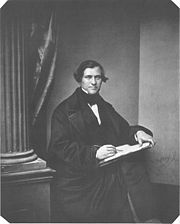
Johann Schraudolph
Encyclopedia

As pupil and assistant of Heinrich Maria von Hess, he painted five scenes from the life of St. Boniface in the basilica at Munich
St. Boniface's Abbey, Munich
St. Boniface's Abbey is a Benedictine monastery in Munich, Bavaria, Germany. It was founded in 1835 by King Ludwig I of Bavaria, as a part of his efforts to reanimate the country's spiritual life by the restoration of the monasteries destroyed during the secularisation of the early 19th century....
: St. Boniface preaching; his consecration as bishop; the cutting down of Thor's oak; the anointing of Pepin; and the burial of St. Boniface. Hess had already tested his work in the Church of All Saints where Schraudolph had painted scenes from the history of Moses, figures of David, Saul, etc. (which were destroyed by bombing in World War II
World War II
World War II, or the Second World War , was a global conflict lasting from 1939 to 1945, involving most of the world's nations—including all of the great powers—eventually forming two opposing military alliances: the Allies and the Axis...
). Some of his devotional pictures became very popular: the Virgin with the Child Jesus; St. Agnes; Christ as the Friend of children; a eucharist
Eucharist
The Eucharist , also called Holy Communion, the Sacrament of the Altar, the Blessed Sacrament, the Lord's Supper, and other names, is a Christian sacrament or ordinance...
ic service, etc.
On the recommendation of Hess he received an important commission from Ludwig I of Bavaria
Ludwig I of Bavaria
Ludwig I was a German king of Bavaria from 1825 until the 1848 revolutions in the German states.-Crown prince:...
, namely the painting of the frescoes for the cathedral of Speyer
Speyer Cathedral
The Speyer Cathedral, officially the Imperial Cathedral Basilica of the Assumption and St Stephen, in Latin: Domus sanctae Mariae Spirae in Speyer, Germany, is the seat of the Roman Catholic Bishop of Speyer and is suffragan to the Archdiocese of Bamberg. The cathedral, which is dedicated to St...
. Although he had already traveled once through Italy under the guidance of J. Ant. Forster and had made numerous copies of the Old Masters, yet he considered it necessary to make a new journey to Rome and Overbeck for the sake of this, his magnum opus. He made sure of the unity of the series by keeping his assistants (his brother Claudius, Hellweger, Andr. Mayer, etc.) in strict subordination to himself, by retaining for himself the designing of all the compositions for the cupola
Cupola
In architecture, a cupola is a small, most-often dome-like, structure on top of a building. Often used to provide a lookout or to admit light and air, it usually crowns a larger roof or dome....
, the three choirs, and most of those for the nave
Nave
In Romanesque and Gothic Christian abbey, cathedral basilica and church architecture, the nave is the central approach to the high altar, the main body of the church. "Nave" was probably suggested by the keel shape of its vaulting...
, by drawing the most important cartoons and painting the most difficult pictures himself. The unifying conception of all the frescoes is: the Divine plan of salvation with special reference to the Blessed Virgin and the other patron saints of the cathedral, the deacon
Deacon
Deacon is a ministry in the Christian Church that is generally associated with service of some kind, but which varies among theological and denominational traditions...
Stephen, Pope St. Stephen
Pope Stephen I
Pope Saint Stephen I served as Bishop of Rome from 12 May 254 to 2 August 257.Of Roman birth but of Greek ancestry, he became bishop of Rome in 254, having served as archdeacon of Pope Lucius I, who appointed Stephen his successor....
, and St. Bernard
Bernard of Clairvaux
Bernard of Clairvaux, O.Cist was a French abbot and the primary builder of the reforming Cistercian order.After the death of his mother, Bernard sought admission into the Cistercian order. Three years later, he was sent to found a new abbey at an isolated clearing in a glen known as the Val...
. After the completion of this undertaking Schraudolph enjoyed the favour of the king, who frequently inspected the numerous oil-paintings produced in Schraudolph's studio, and at times bought them for himself or the Alte Pinakothek
Alte Pinakothek
The Alte Pinakothek is an art museum situated in the Kunstareal in Munich, Germany. It is one of the oldest galleries in the world and houses one of the most famous collections of Old Master paintings...
.

